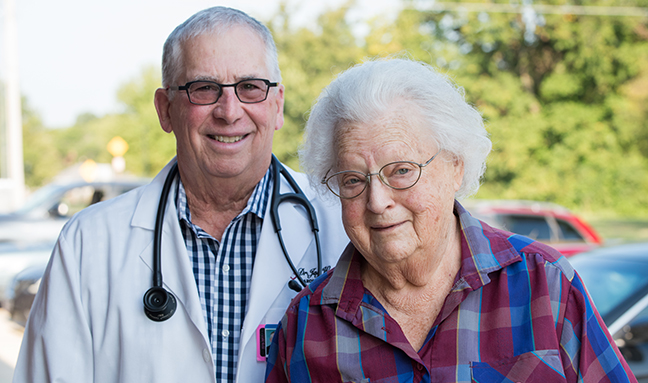(Pictured) Madelyn Madden underwent a life-saving heart procedure at Olathe Medical Center. She now receives ongoing care from cardiologist Dr. Jay Murphy at the Cardiology Services clinic in Ottawa.
It was supposed to be a relaxing vacation with family in Branson, Missouri in December 2016 – a new tradition for Madelyn Madden and nearly 30 of her family members to celebrate the holidays. Madelyn, an 82-year-old mother of seven from Ottawa, was headed to bed late one night when she began to feel “funny.” As someone who had suffered a heart attack years before, she recognized the symptoms and woke her daughter, a cardiac rehabilitation nurse, who called 9-1-1.
Paramedics rushed Madelyn to a hospital in Branson, where they diagnosed four blockages in her coronary arteries, including one in the infamous “widow maker,” the left anterior descending (LAD) artery.
Over the next two days, Madelyn’s doctors helped to stabilize her, but recommended she be transferred to a hospital that could handle her complex cardiac health issues. Madelyn’s family quickly contacted doctors with Olathe Health to have her transferred to Olathe Medical Center (OMC). Dr. Jay Murphy, a cardiologist at Olathe Health Cardiology Services, and Dr. James Miller, a cardiothoracic surgeon at Olathe Health Kansas Heart & Lung Surgeons, jumped in to consult on her case and worked closely with the Branson care team to arrange an ambulance transfer.
Upon her arrival at OMC, Dr. Dusan Stanojevic, an interventional cardiologist, assessed Madelyn’s condition.
“Ms. Madden had severe blockages in her heart arteries, and after reviewing her tests and imaging results, Dr. Miller, I and the rest of our heart team decided cardiac catheterization, a less invasive procedure, would be the best option to open the blocked arteries because of her advanced age and multiple health issues.
Dr. Stanojevic performed cardiac catheterization using a special diamond drill that rotates at 150,000 revolutions per minute to clear calcified blockages in Madelyn’s heart, and then placed cardiac stents to keep the blockage opened. All of this was done using a thin, hollow catheter inserted in the coronary arteries. Because this was a high-risk procedure, the team was prepared to transition to open-heart surgery at any time during Madelyn’s procedure.
Since this was a minimally-invasive procedure, Madelyn recovered at OMC for just a few days and then was well enough to head home on Christmas night.
“I couldn’t have asked for better care,” Madelyn said. “I was thankful to be close to home, where I was surrounded by my family. I loved my doctors, and the nurses-especially the fourth floor nurses-took wonderful care of me. They’ve supported me the entire time. There was never any doubt this is where I needed to be.”
Because of her age and extensive heart disease, Madelyn suffered another heart attack in June. She was rushed by ambulance from Ottawa to OMC, where Dr. Stanojevic performed another cardiac catheterization and opened a different blockage that Madelyn had developed.
Today, Madelyn is feeling stronger and spends her days working for her family’s company in Ottawa. She follows up regularly with Dr. Murphy at the Cardiology Services clinic near her home in Ottawa, and takes blood thinner medication to help reduce her risk of future heart attacks.

